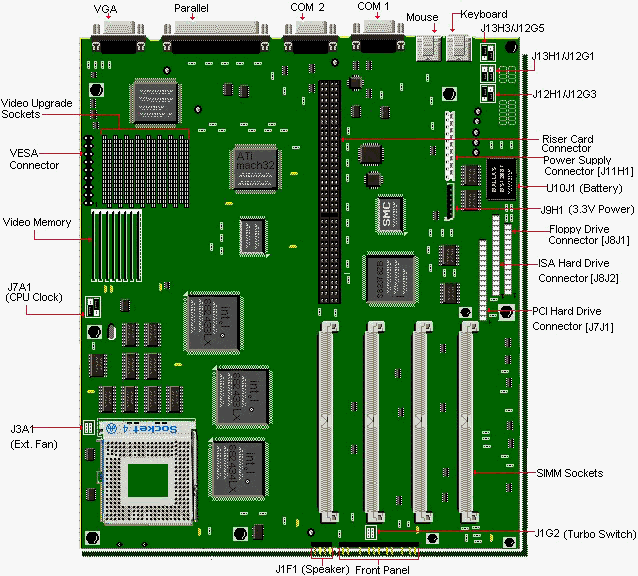 Acer File Extensions |
Packard Bell 520 M/Board

The on-board video chip of your computer will automatically be disabled by the installation of a separate video card.
Specification
- Battery : Integrated into RTC chip.
- BIOS : Flash EEPROM - AMI BIOS.
- Bus Architecture : PCI 2.0/ISA based system bus. 66MHz maximum bus speed
- Cache : 16K level 1 cache 256k level 2 cache.
- Chipset :
- Intel® 82441FX PCI and Memory Controller.
- Intel® 82442FX(DBX) Data Bus Accelerator.
- Intel® 82371SB PCI/ISA Bridge.
- CPU : Type 4 CPU Zero Insertion Force (ZIF) CPU Socket.
- Interfaces :
- 2 DB-9 Serial ports for COM1 and COM2.
- 1 DB-25 Parallel port.
- 1 PS/2 Keyboard port.
- 1 PS/2 Mouse port.
- RAM : 2MB minimum/ 128M maximum Uses 1/2/4/8/16/32MB 72-pin SIMMs, @ 70ns.
- Speaker : Diaphragm on chassis.
- UART : 16C550A Compatible.
- Video : Built-in, ATI Mach32 extended VGA.
- Video RAM : upgradable to 2 MB.
Jumpers
| Jumper | Function | Pin/Setting | Description |
|---|---|---|---|
| J12H1 | Flash Boot Block | 1-2 2-3 | Recovery Mode Normal Mode * |
| J12H1 | Flash Write | 4-5 5-6 | Enabled * Protected |
| J13H1 | CMOS Clear | 1-2 2-3 | Normal * Clear |
| J13H1 | Password | 4-5 5-6 | Normal * Clear |
| J13H3 | VGA Mode | 1-2 2-3 | Monochrome Colour * |
| J13H3 | VGA Mode | 4-5 5-6 | Enable * Disable |
| J7A1 | CPU Speed | 1-2 2-3 | 66 MHz 60 MHz * |
| Setup | CMOS Setup | 1-2 2-3 | Enable * Disable |
* Indicates default value
Note - J7A1 - This setting cannot be changed.
Battery
The battery is a Dallas DS 12887 real time clock and CMOS battery integrated into the RTC chip. This chip is soldered onto the motherboard and is not replaceable.
BIOS
The BIOS in the PB520 is contained in Flash EEPROM, and it can be updated via software. If the Flash BIOS is corrupted during an update, it is possible to recover it.To run the BIOS update,
1. Insert the update diskette into drive A: and reboot the system.
2. When the opening dialogue appears, press (enter).
3. The Main Menu will appear on the screen.
4. Select "Update Flash Memory Area from a file" using the Down Arrow key.
5. Press (enter).
6. The UPDATE FLASH AREA dialog box appears on the screen.
7. Select "Update System Bios".
8. Press (enter).
9. Press the Down Arrow key to select 1006au0r.bi0 file.
10. Press (enter).
11. Highlight the (continue with programming)option and press (enter).
12. Remove the disk from drive A and press (enter).
BIOS Recovery
To recover from a corrupted BIOS, perform the following steps:
1. Turn off the system.
2. Remove the system's case and move the jumper block on J12H1 from pins 2-3 to pins 1-2. Leave the jumper block on pins 4-5 in place.
3. Place the update diskette in drive A: and turn on the system.
4. There will be no video display during the BIOS recovery, this is due to the small amount of code available in the non-erasable boot block area.
5. After the system boots, it will beep once and the floppy drive light should light up. The system is copying the recovery code into the Flash EEPROM.
6. Just before the recovery completes, the system will beep twice. Once this occurs, watch the floppy drive light. When the light goes off, turn off the system.
7. Move the jumper block on J12H1 from pins 1-2 back to pins 2-3.
8. Turn the system on and repeat the steps for updating the BIOS.
Cache Upgrade
The motherboard comes with 16KB of cache integrated in the processor ( CPU ). A secondary external cache level (write-back cache ) of 256KB is soldered on the motherboard. This cannot be upgraded.
CPU Upgrades
This motherboard can accommodate any of the following CPUs.
- Intel Pentium 60 MHz
- Intel Pentium Overdrive Processor (P5T) 120 MHz.
The upgrade processor installs in the Zero Insertion Force (ZIF) socket location U2B1. Jumpers do not need to be changed.
Memory Upgrades
- This motherboard does not accept EDO memory.
- SIMM speed must be 60 or 70ns.
- The SIMMS are 4/8/16/32MB 72-pin and can be x32 or x36 because the motherboard design does not require parity checking.
- Use silver plated SIMMS (Do not use gold plated SIMMS).
- The motherboard of this system comes in two different revisions. One contains 2 SIMM sockets (can max. be upgraded to 72MB), the other one contains 4 SIMM sockets (can max. be upgraded to 136MB).
- Upgrade in pairs. This means you have to fill a bank completely. E.g. when upgrading the system with 16MB, you have to use two 8MB SIMMS instead of one 16MB.
- This system already has 8MB of RAM memory soldered onto the motherboard, regardless the number of SIMM sockets.
Video Memory Upgrade
The video memory on this system can be upgraded to 2MB, by using two 256Kx16-70ns SOJ DRAM chips.